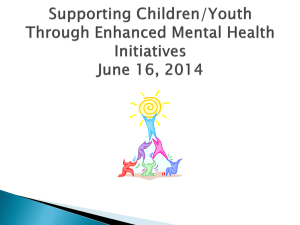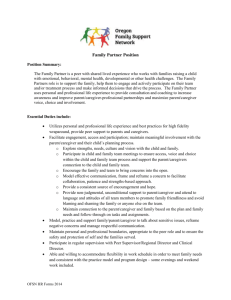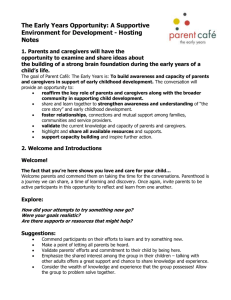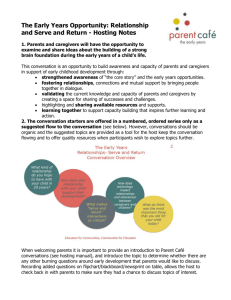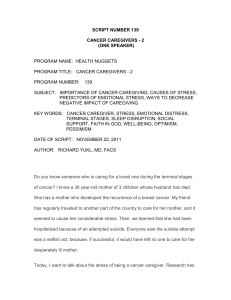Suggestion - Café Institute
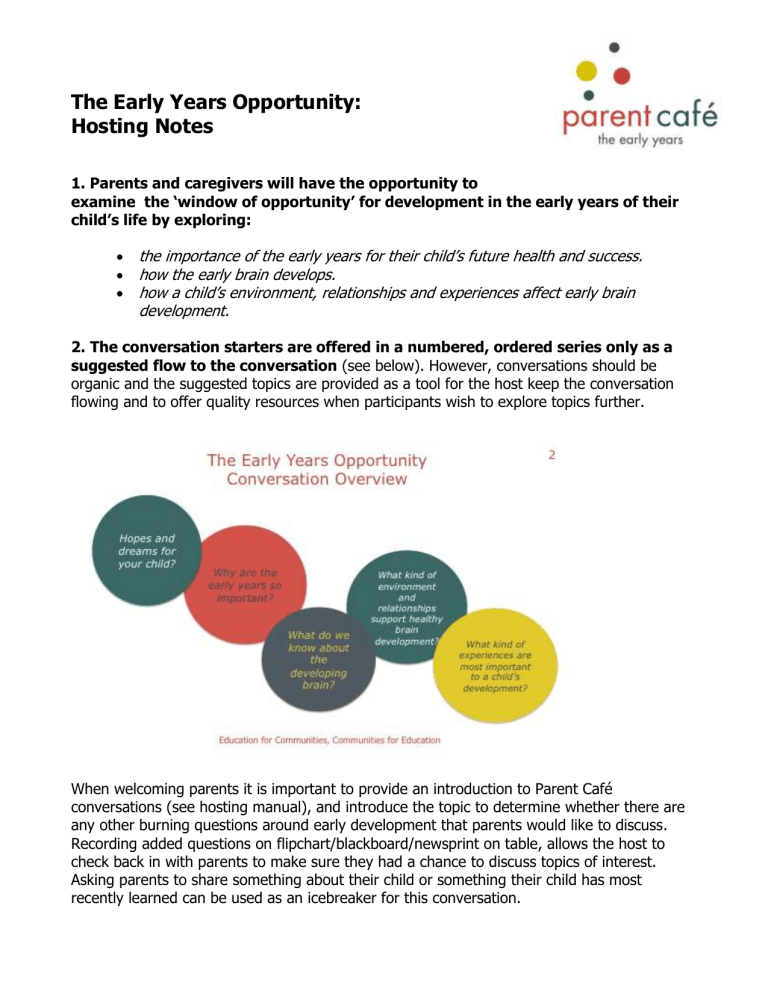
The Early Years Opportunity:
Hosting Notes
1. Parents and caregivers will have the opportunity to examine the ‘window of opportunity’ for development in the early years of their child’s life by exploring:
the importance of the early years for their child’s future health and success.
how the early brain develops.
how a child’s environment, relationships and experiences affect early brain development.
2. The conversation starters are offered in a numbered, ordered series only as a
suggested flow to the conversation (see below). However, conversations should be organic and the suggested topics are provided as a tool for the host keep the conversation flowing and to offer quality resources when participants wish to explore topics further.
When welcoming parents it is important to provide an introduction to Parent Café conversations (see hosting manual), and introduce the topic to determine whether there are any other burning questions around early development that parents would like to discuss.
Recording added questions on flipchart/blackboard/newsprint on table, allows the host to check back in with parents to make sure they had a chance to discuss topics of interest.
Asking parents to share something about their child or something their child has most recently learned can be used as an icebreaker for this conversation.
3. What brought you here today?
What motivated you to take time out from your busy life?
There are many reasons that parents/caregivers have for taking the time to learn more about their child and explore their important role as a parent. This discussion may provide an indication of questions that the group may wish to address.
Finding why parents have committed to coming out to the Café offers a chance for parents to share something personal about themselves and the opportunity to get to know one another.
There are many reasons that parents/caregivers have for taking the time to learn about their child. Something motivated each parent/caregiver to be here.
Suggestions:
Make a point of letting all parents be heard.
Validate parents efforts and commitment to their child by being here.
Emphasize the shared interest among the group in their children – talking with other adults offers a great support and chance to share knowledge and experience.
Consider the wealth of knowledge and experience that the group possesses!
4. What are your hopes and dreams for your child’s future?
Caring leads to action…
Dreaming helps to focus on the amazing possibilities ahead. When people connect to the heart they often find the motivation to act. By setting the stage for a casual and open conversation, parents often feel comfortable and supported which then helps to create an environment where they feel they can speak honestly.
Suggestion: Have parents explore this strength-based question to validate their efforts.
How are you already supporting your child with these hopes and dreams?
Examples.:
make sure they are healthy and loved
proper nutrition
family influence
others?
Helping parents to articulate their hopes and dreams for their child can highlight the importance of the foundation of these early years and provide a context for their efforts to support healthy development.
5. Why are the early years so important?
The early years are so important in a child’s development because their growth and development lays the foundation for a healthy future.
Examples from parents:
• Children learn to walk and talk
• They build the skills they need to be ready for school
• Children learn basic social skills at a young age
• Others?
Did you know?
Many children are on the right track in their development. However, 1 in 4 kindergarten children in Calgary and area are experiencing difficulty in 1 or more domains of development.
For more information see
EC Map project with the revised provincial data now available:
The 5 domains of development (as measured in Alberta) by the EDI instrument as part of the
EC mapping project are:
Physical well-being
Social competence
Emotional maturity
Language and thinking skills
Communication and general knowledge
The great news is that Calgary and area really cares! 11 coalitions now working across
Calgary and area in as part of the First 2000 Days Network.
The First 2000 Days network is a collaboration of individuals and groups in Calgary and area. It is open to all who are joined by a common goal: all children from conception to six are supported by family and community in order to reach their optimal development. Find updates, links and resources and opportunities to be involved and make a difference.
Suggestion: share and discuss these statements:
“Child development is a foundation for community development and economic development, as capable children become the foundation of a prosperous and sustainable society… All aspects of human capital, from work force skills to cooperative and lawful behavior, build on capacities that are developed during childhood, beginning at birth.”
Source: The Science of Early Childhood Development,
National Scientific Council on the Developing Child, Harvard University or:
“It takes a community to raise a child. The first 2000 days of a child's life is a time of tremendous growth and learning. The early years set the course for a child's future and we want that future to be the brightest possible!” source: Ready 4 Learning
6. Exploring together: The Core Story of Brain Development
View the short video from the Alberta Family Wellness Initiative:
How Brains are built: The Core Story of Brain Development
What are your reactions? What strikes you the most?
The Alberta Family Wellness Initiative, supported by the Norlien Foundation, is committed to sharing what scientists are calling “the core story of brain development”. While we might have thought in the past that our genetics determined who we would become, we now know that our experiences in the first years of our life actually determine how our brain will be built. The core story video contains these key points:
Brains aren’t just born but built over time based on our experiences; experiences in the first years of life affect the physical architecture of the developing brain. The brain acquires the tool kit it needs for all later development and learning during the early years. The potential to affect positive change during this time is enormous.
A brain needs a sturdy foundation or base to support all future development and provides a base for a lifetime of good mental function and better overall health.
Brains, just like houses, are built from the bottom up. Its easiest to “get things right” the first time! Repairing the “foundation” later is more work and less effective.
Positive interactions between caregivers and young children actually build the architecture of the developing brain.
A solid foundation is built and maintained through “serve and return” interactions between a child and their caregiver. This communication and back and forth interaction, eye contact, touch, singing, talking playing games, repeated over the course a child’s early years actually provides the “bricks” to build a healthy foundation for future development!
Stress also plays a role in shaping brain architecture and development. Some stress is positive, like meeting new people, is part of healthy development. “Toxic”, or prolonged severe stress, without the protection of a loving caregiver can leave a child at risk for a lifetime of health and developmental problems and even addiction.
Sturdy brain architecture supports the development of basic social and emotional skills.
A child begins to develop their “air-traffic control system”, a necessity for positive mental health. These are the skills that scientists call emotional regulation and executive function, those which allow a child to learn to pay attention, plan ahead, remember to follow rules, to regulate the flow of information, and to prioritize tasks and manage stress.
Additional suggested resources:
Brain Architecture and Development Summary – (Alberta Family Wellness Initiative)
Sharing the Brain Story: The AFWI’s Knowledge Mobilization Strategy
The Science of Early Childhood Development , (video) - J.Shonkoff, Centre for Developing Child,
Harvard Education.
6a.
Some other miracles of early brain development and early experience:
Babies’ brains are not just a smaller version of an adult brain, but really born ready to learn. The first five years of life will determine how their brain develops, with
85% of the brain’s wiring happens between birth and age 5! .
The lower areas of the brain are more mature at birth - that’s why newborns can breath, sleep, cry and feed. The higher areas, where conscious thinking, feeling, remembering and voluntary actions come from are still under construction.
Most of the neurons, or nerve cells have been formed but few of the connections are yet made between them. These connections ( synapses) form the pathways
( brain circuits) that connect one area of the brain to another, as areas of the brain develop and specialize, allowing us to do most of what we can do.
Enormous numbers of connections are formed in a child’s brain. The brain then begins “pruning”, or eliminating some synapses and strengthening others in order to be more efficient. Connections and pruning of synapses and neural circuits are dependent on experiences.
Development of different brain areas occurs in a sequential pattern. More basic skills are learned first and built on with more complex skills.
Early brain development impacts all areas of adult life: Foundational skills in all areas of development (physical or motor skills, social, emotional, thinking and language skills) are all learned in the first 2000 days!
Suggestion:
Watch the BBC short video Early Brain Development 01
7. What kind of environment best supports healthy brain development and learning?
Do you think infants and young children feel stress?
An environment supportive of healthy development and learning:
Meets physical needs, including sleep, nutrition, exercise and protection from physical harm. Things that are tolerated by a mature brain can be toxic to a young brain.
Is secure and predictable, with limited stress.
Includes a consistent, loving caregiver!
A healthy environment includes a consistent, loving caregiver! Positive care giving can buffer a child from the impacts of stress! You can explore some of the links below for more on this.
“The development of supportive environments for children is key to both reduce their exposure to toxic stress and create buffers of support to make stressful life events more tolerable.” From AFWI,
Positive, Tolerable & Toxic Stress
Early in a child’s life their brain is most plastic, or able to change and adapt as a result of their environment. This means a child’s brain is most susceptible to input, most vulnerable to harm and most capable of recovery at this time in their life! It is important to note with parents however, that healthy relationships, environment and experiences continue to impact older children and healthy development – it is never too late, it is just harder work! The dance between genetic and environmental influences plays out as the genetic blueprint is read and interpreted, under the influence of the environment. A healthy environment is essential for a child to reach their optimal development! Read more: AFWI provides a summary of Brain Plasticity & Behavioral Change
Of course the physical needs of a child must be met to support optimal development, including sufficient sleep and rest, healthy nutrition, exercise and protection from physical harm. Remember, conditions that may be tolerated by a mature brain can be toxic to a young, developing brain.
We know that infants and your children do experience stress, and that a stressful environment can have serious impacts on brain development. A secure and predictable environment with stable supportive relationships limits stress. Some stress is a normal part of life! Positive, or moderate, shortlived stress, causes a brief increase in heart rate and mild changes in stress hormones. Things like meeting new people or dealing with frustration are part of healthy development when a child has stable, supportive relationships. Toxic stress, high levels of prolonged stress experienced without the presence of a consistent, loving caregiver can derail healthy development, wiring a child to be very sensitive to stress, and vulnerable to develop physical and mental health struggles including addiction throughout their life.
Explore:
Watch this short video from the Center on the Developing Child – Harvard University
Toxic Stress Derails Healthy Development
“Promoting children’s mental health is like using a sugar packet to level a table. The table can’t function properly if it is on a slanted floor or if one of its legs is uneven. Similarly, children can’t function fully if the environment in which they grow is unstable. This affects their mental health and undermines their development. The table can’t level itself: we have to step in and provide assistance to steady the table’s base.
Source: Sharing the Brain Story, Alberta Family Wellness Initiative
8. How can you limit stress for your child?
Stress is a normal part of life. The positive aspects of stress such as meeting new people, adjusting to new situations, etc. can help provide your child with skills to learn to cope. There are many day to day aspects of parenting and care giving that can help to alleviate stress:
Create an environment that feels safe and secure
Follow predictable routines and regular patterns
Bedtime routines help children transition and relax at the end of the day.
Morning routines can help to get the day off to a good start.
Offer warm, responsive care-giving, i.e. comforting our child when upset
Ensure our child gets enough rest and sleep – tired children are more easily stressed
Make time for exercise and play time
Provide healthy food that can helps children cope with stress more easily.
Have realistic, developmentally appropriate expectations of their child
Spend time with their child, showing them they are loved.
Have fun together and remembering to laugh!
Learn to manage our own stress.
Others?
9. How does your relationship with your child support their development?
Relationships between parents/caregivers and children are key to healthy development.
“Attachment” is the word used to describe the emotional bond between infants and parents or caregivers. Secure attachments are formed through the emotional bonding that happens when parents care for their child and respond to their needs. Attachment begins even before birth and plays an important role in brain development!
While a child may not consciously remember, their early life attachments are processed by the limbic system, and stored as emotional memory.
During the sensitive periods of brain development, healthy attachments are so important, actually contributing to shaping the architecture of the brain!
We know that stress can have negative effects on a developing brain but the consistent, positive care-giving in an environment of relationship can buffer a child from this toxic effect!
Secure attachments also contribute to creating the safe environment that children need to learn and grow, impacting their self-confidence and independence and contributing to less stress reactivity and better relationships throughout their life! A positive, nurturing relationship with a caregiver is one of the most important ways to promote and support the healthy social, emotional, and cognitive development of a young child!
We know that stress can have negative effects on a developing brain but the consistent, positive care-giving in an environment of relationship can buffer a child from this toxic effect!
Healthy development happens in the context of relationships!
This discussion may lead into the next question focused on experiences, highlighting the importance of serve and return interactions.
Suggestions:
Explore and share: Staying Connected:
Child and family therapist Jennifer Kolari explains how positive parenting stimulates the production of oxytocin in a child's brain and how that benefits the child and the parents
Explore and share: the video Science in Seconds: Early Brain Development from the
Alberta Family Wellness Initiative site provides a summary of how relationships build brains and can protect young children from the effects of toxic stress. This video may be appropriate to share during your conversation.
10. What kinds of experiences are most important for a child’s development?
Creating an environment rich with learning experiences supports the growth in a young child’s brain. New and novel experiences will support new synapses to be formed.
However, in order for connections to be strengthened they must be used! Early connections that that are unused will be lost through pruning while connections that are used often will be strengthened. A child needs new and novel experiences but also opportunities to repeat and practice what they have done before!
There is plenty of opportunity for rich learning and growth in the normal, everyday
world of a child! Children given time to explore and discover are given the opportunity to stimulate their senses, learn to plan and problem-solve, learn self-control and deal with frustration! Opportunities to rehearse and practice as they begin to learn newly acquired skills supports strengthening of neural connections. Children will then extend to the next new skill, with their innate drive to build on and master more complex skills. Knowing what stage a child is at developmentally, we can understand how best to support them. Once again, stress can get in the way of learning, as children who experience high levels of stress are less likely to explore and practice new skills.
Suggestion: explore together: Winning Ways to Talk to Young People.
Office of Childcare Policy, Children’s Administration, Washington State Department of Social and Health Services.
Why are “serve and return” interactions between a child and caregiver so important for building a healthy brain?
Serve and return interactions between a child and a caregiver are the back and forth interactions and communication that happen through eye contact, touch, singing, talking and games. Repeated over the course a child’s early years, these interactions actually provide the
“bricks” to build a healthy foundation for future development! What’s makes “serve and return” interactions so special? They are part of an ongoing caregiver – child relationship, are responsive to child reaching out and to the individual child and their developmental needs, they build on child’s interests and current capabilities, and shape the child’s self-awareness and sense of who they are in the world. Serve and return interactions buffer a child’s stress response and are essential prerequisites for the development of healthy brain circuits and more complex skills!
Suggested resources:
Review the video: Three Core Concepts in Early Development, Experiences Build Brain Architecture from Harvard University’s Centre on the Developing Child. Washington State Department of Health
Explore the Center on the Developing Child – Harvard University’s Serve and Return Interaction
Shapes Brain Circuitry .
From AFWI, the article Early Experiences & Gene Expression relates serve and return interactions to how genes our expressed!
11. Why is it so important for a child to get their “air traffic control system ”up and running?
The pre-frontal cortex of the brain is an area that does not fully mature until early adulthood though important foundational learning begins in early childhood. The critical set of skills that develop in this part of the brain, known as self-regulation and executive function, are like the air-traffic control system at a busy airport. They allow us to focus and pay attention, regulate the flow of information, create mental priorities, to follow rules, make and revise plans and decisions… and avoid “collisions”.
This area of development seems to be profoundly susceptible to the impacts of toxic stress – in high stress environments children as young as two are falling behind.
These skills provide a biological foundation for future successful learning and social relationships, impacting all realms of development.
Suggested resource:
Tools of the Mind is a research-based early childhood program that builds strong foundations for school success by promoting intentional and self-regulated learning in preschool- and kindergarten-aged children. Tools’ instructional philosophy is inspired by the work of Russian psychologist Lev Vygotsky and his students, and at the same time, is rooted in cutting edge neuropsychological research on the development of self-regulation/executive functions in children.
Review and discuss with parents;
Tools of the mind, What Parents Need To Know About Supporting Self-Regulation strategies for modeling self-regulation.
model their own behaviors in intentional ways. (ie. planning, deliberate behavior, planning)
Having an environment that is free of distractions is another way or supporting self-regulation at home.
engage in mature make-believe play. Parents, therefore, need to act as “play mentors,” modeling various components of make-believe play for their children.
• establishing routines.
Suggestions:
12. After our discussion today, would you like to set a goal or try something new to?
What would you like to share with another parent or caregiver?
Great ideas from parents:
Examples:
Check out the Ready4Learning website for local opportunities.
Find my coalition contact for the EC Map project in my area and find out what’s happening in our neighborhood. www.ready4learning.org
Sign up for With the brain in mind…
Reminder: provide any follow up information requested…

